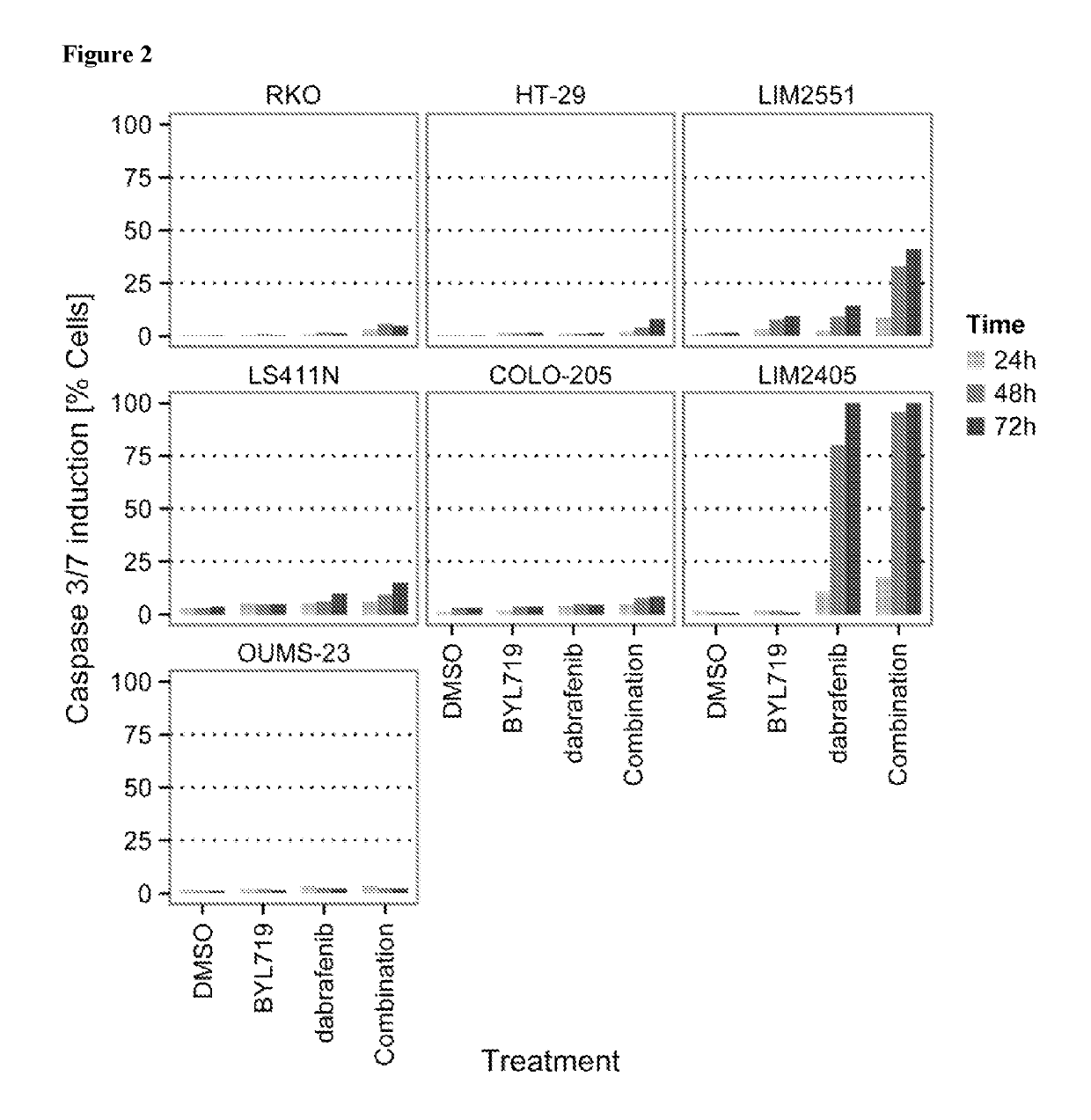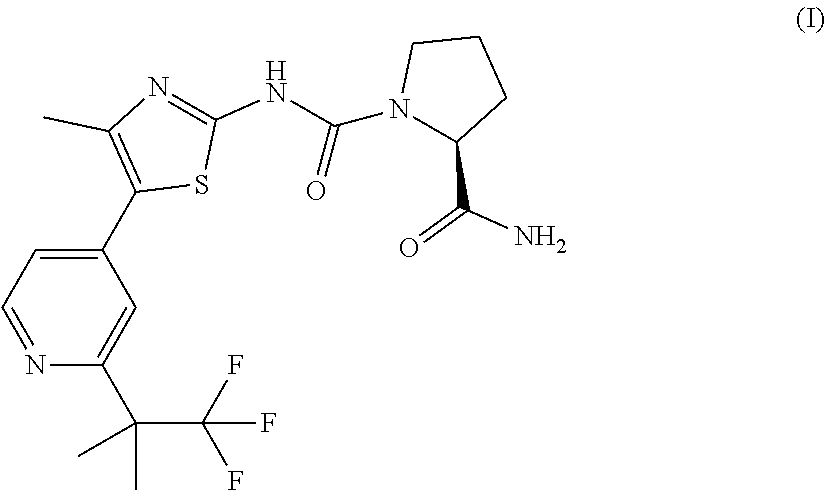Pharmaceutical combination comprising the PI3K inhibitor alpelisib and the B-RAF inhibitor dabrafenib; the use of such combination in the treatment or prevention of cancer
a technology of braf inhibitor and pi3k inhibitor, which is applied in the direction of antineoplastic agents, drug compositions, medical preparations, etc., can solve the problems of refractory to treatment, and achieve the effects of reducing side effects, reducing side effects, and prolonging respons
- Summary
- Abstract
- Description
- Claims
- Application Information
AI Technical Summary
Benefits of technology
Problems solved by technology
Method used
Image
Examples
example 1
I. Synthesis of (S)-Pyrrolidine-1,2-dicarboxylic acid 2-amide 1-{[5-(2-tert-butyl-pyridin-4-yl)-4-methyl-thiazol-2-yl]-amide}
[0128]
[0129]Et3N (1.54 mL, 11.1 mmol, 3 eq) is added to a solution of imidazole-1-carboxylic acid [5-(2-tert-butyl-pyridin-4-yl)-4-methyl-thiazol-2-yl]-amide (Step 1.1) (1.26 g, 3.7 mmol) and L-prolinamide (0.548 g, 4.8 mmol, 1.3 eq) in DMF (25 mL), under an argon atmosphere. The reaction mixture is stirred for 14 h at rt, quenched by addition of a saturated solution of NaHCO3, and extracted with EtOAc. The organic phase is washed with a saturated solution of NaHCO3, dried (Na2SO4), filtered and concentrated. The residue is purified by silica gel column chromatography (DCM / MeOH, 1:0→94:6), followed by trituration in Et2O to afford 1.22 g of the title compound as an off-white solid: ESI-MS: 388.1 [M+H]+; tR=2.35 min (System 1); TLC: Rf=0.36 (DCM / MeOH, 9:1). 1H NMR (400 MHz, DMSO-d6) δ(ppm): 1.32 (s, 9H) 1.75-1.95 (m, 3H) 1.97-2.13 (m, 1H) 2.39 (s, 3H) 3.38-3.50...
example 2
of Compound (II) (COMPOUND B)
Method 1: Compound B (first crystal form)—N-{3-[5-(2-Amino-4-pyrimidinyl)-2-(1,1-dimethylethyl)-1,3-thiazol-4-yl]-2-fluorophenyl}-2,6-difluorobenzenesulfonamide
[0147]
[0148]A suspension of N-{3-[5-(2-chloro-4-pyrimidinyl)-2-(1,1-dimethylethyl)-1,3-thiazol-4-yl]-2-fluorophenyl}-2,6-difluorobenzenesulfonamide (196 mg, 0.364 mmol) and ammonia in methanol 7M (8 ml, 56.0 mmol) was heated in a sealed tube to 90° C. for 24 h. The reaction was diluted with DCM and added silica gel and concentrated. The crude product was chromatographed on silica gel eluting with 100% DCM to 1:1 [DCM:(9:1 EtOAc:MeOH)]. The clean fractions were concentrated to yield the crude product. The crude product was repurified by reverse phase HPLC (a gradient of acetonitrile:water with 0.1% TFA in both). The combined clean fractions were concentrated then partitioned between DCM and saturated NaHCO3. The DCM layer was separated and dried over Na2SO4. The title compound, N-{3-[5-(2-amino-4-p...
example 3
tro Effect on Proliferation of Combining the PIK3CA Inhibitor BYL719 (COMPOUND A) with the BRAF Inhibitor Dabrafenib (COMPOUND B) in BRAF Mutant Colorectal Cancer Cell Lines
[0161]COMPOUNDS A and B were dissolved in 100% DMSO (Sigma, Catalog number D2650) at concentrations of 20 mM and stored at −20° C. until use. Compounds were arrayed in drug master plates (Greiner, Catalog number 788876) and serially diluted 3-fold (7 steps) at 2000× concentration.
[0162]Colorectal cancer cell lines used for this study were obtained, cultured and processed from commercial vendors ATCC, HSRRB, and CellBank Australia (Table 1). All cell line media were supplemented with 10% FBS (HyClone, Catalog number SH30071.03). Media for LIM2405 and LIM2551 was additionally supplemented with 0.6 μg / mL Insulin (SIGMA, Catalog number 19278), 1 μg / mL Hydrocortisone (SIGMA, Catalog number H0135), and 10 μM 1-Thioglycerol (SIGMA, Catalog number M6145).
[0163]
TABLE 1Cell line informationTreatmentCell lineDriver mutation...
PUM
| Property | Measurement | Unit |
|---|---|---|
| body weight | aaaaa | aaaaa |
| body weight | aaaaa | aaaaa |
| body weight | aaaaa | aaaaa |
Abstract
Description
Claims
Application Information
 Login to View More
Login to View More - R&D
- Intellectual Property
- Life Sciences
- Materials
- Tech Scout
- Unparalleled Data Quality
- Higher Quality Content
- 60% Fewer Hallucinations
Browse by: Latest US Patents, China's latest patents, Technical Efficacy Thesaurus, Application Domain, Technology Topic, Popular Technical Reports.
© 2025 PatSnap. All rights reserved.Legal|Privacy policy|Modern Slavery Act Transparency Statement|Sitemap|About US| Contact US: help@patsnap.com



